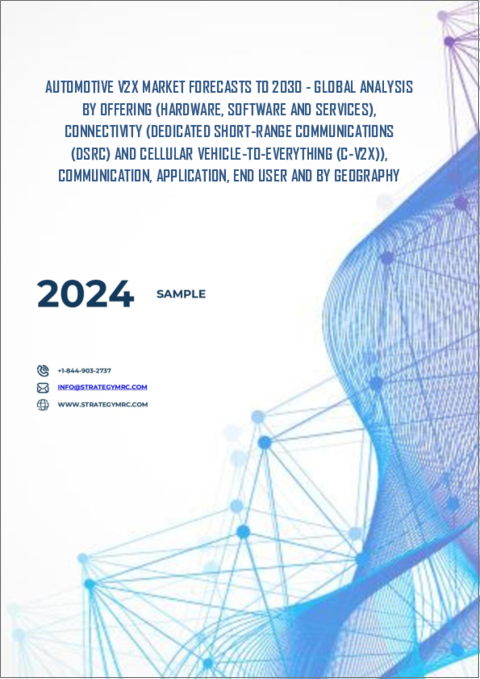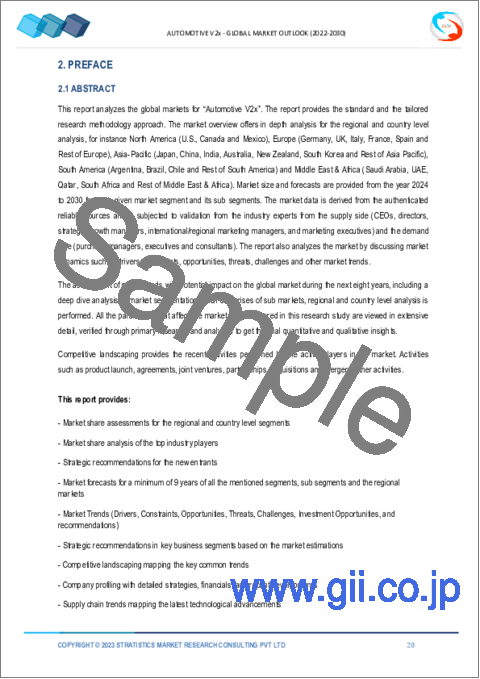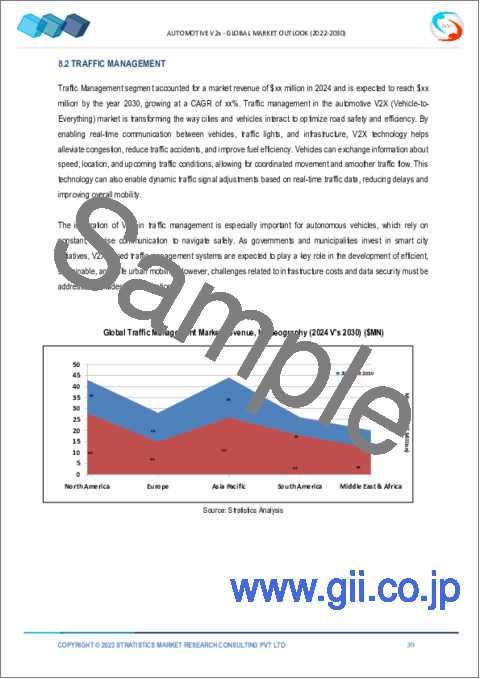|
|
市場調査レポート
商品コード
1587600
自動車V2X市場の2030年までの予測: オファリング別、コネクティビティ別、通信別、用途別、エンドユーザー別、地域別の世界分析Automotive V2X Market Forecasts to 2030 - Global Analysis By Offering, Connectivity (Dedicated Short-Range Communications and Cellular Vehicle-to-Everything ), Communication, Application, End User and By Geography |
||||||
カスタマイズ可能
|
|||||||
| 自動車V2X市場の2030年までの予測: オファリング別、コネクティビティ別、通信別、用途別、エンドユーザー別、地域別の世界分析 |
|
出版日: 2024年11月11日
発行: Stratistics Market Research Consulting
ページ情報: 英文 200+ Pages
納期: 2~3営業日
|
全表示
- 概要
- 図表
- 目次
Stratistics MRCによると、世界の自動車V2X市場は2024年に8億5,000万米ドルを占め、予測期間中のCAGRは52.7%で2030年には98億7,000万米ドルに達すると予測されています。
自動車V2X(Vehicle-to-Everything)とは、自動車が他の車両(V2V)、インフラ(V2I)、歩行者(V2P)、ネットワーク(V2N)を含む環境の様々な要素と相互作用することを可能にする通信技術のことです。この技術により、リアルタイムのデータ交換が容易になり、交通安全の向上、交通効率の改善、スマート交通システムの開発がサポートされます。高度な通信プロトコルを活用することで、V2Xは事故を減らし、交通の流れを最適化し、自律走行機能を実現し、より接続されたインテリジェントな交通エコシステムに貢献することを目指しています。
マッキンゼーの調査によると、コネクティビティ、V2I/V2X(Vehicle-to-Infrastructure、Vehicle-to-Everything)通信ソリューションは、2020年に約180億米ドルの支出を見込んでいます。
都市化と交通渋滞
都市人口の増加に伴い、都市は交通課題の高まりに直面し、通勤時間の長期化、事故の増加、排気ガスの増加につながります。V2X技術は、車両とインフラ間のリアルタイム通信を可能にすることで、これらの問題に対処し、より良い交通管理、最適化されたルーティング、安全性の向上を促進します。この技術は、 促進要因の状況認識を高め、渋滞を緩和し、持続可能なモビリティ・ソリューションを促進します。その結果、都市計画者や政府は、よりスマートで安全かつ効率的な都市交通ネットワークを構築するため、V2Xシステムへの投資を増やしています。
標準化の欠如
自動車V2Xにおける標準化の欠如は、自動車メーカー、テクノロジー・プロバイダー、政府機関など複数の利害関係者が関与し、それぞれが異なる優先順位や技術を持つことから生じています。この分断化により、通信プロトコル、データ形式、セキュリティ対策が多様化し、システム間の相互運用性が複雑化しています。その結果、異なるメーカーの車両が効果的に通信できない可能性があり、V2Xアプリケーションの可能性を十分に発揮できないです。このような不確実性は投資を抑制し、市場導入を阻害します。
通信技術の進歩
5Gや専用短距離通信などの通信技術の進歩は、超低遅延、高データ転送速度、堅牢な接続性を可能にし、車両、インフラ、歩行者間のリアルタイム通信を促進します。通信機能の強化は、衝突回避や交通管理などの安全アプリケーションの有効性を向上させ、メーカーによる採用拡大につながります。さらに、これらの技術が進化するにつれて、自律走行車の高度な機能の統合をサポートし、V2Xソリューションの需要を促進し、スマート交通システムの将来を形作る。
高い実装コスト
自動車V2X市場の導入コストが高いのは、スマート信号機、通信ネットワーク、車両改造などの高度なインフラに多額の投資が必要なことに起因します。さらに、V2X技術の開発と導入には、複雑な統合プロセスと継続的なメンテナンス費用がかかります。こうした経済的障壁は、メーカーや自治体がV2Xソリューションの採用を躊躇させ、市場の成長を制限する要因となります。
COVID-19の影響
COVID-19の流行は、サプライチェーンを混乱させ、車両生産を遅らせ、コネクテッドカー技術の展開を遅らせることで、自動車V2X市場に大きな影響を与えました。モビリティが低下し、健康と安全が重視される中、新車需要は減少しました。しかし、この危機はまた、リモートワークやオンラインサービスの増加に伴い、デジタルソリューションやスマート交通システムへの関心を加速させました。経済が回復するにつれて、V2X技術への関心が高まり、将来の都市環境における交通安全と交通管理が強化されると予想されます。
予測期間中、安全・セキュリティ分野が最大となる見込み
安全・セキュリティ分野は、予測期間を通じて最大の市場シェアを確保すると予測されます。安全・セキュリティアプリケーションにおける車載V2Xは、車両、インフラ、歩行者間のリアルタイム通信を可能にすることで、交通安全を強化します。この技術は、衝突回避、危険警告、緊急車両通知などの機能を促進し、事故リスクを大幅に低減します。交通状況、道路危険、交通弱者の存在に関する重要情報を共有することで、V2Xシステムは 促進要因の状況認識を向上させる。
予測期間中、乗用車セグメントのCAGRが最も高くなると予想されます。
乗用車セグメントは、運転体験と安全性の向上により、予測期間中に最も高いCAGRを記録すると予想されます。この技術は、交通信号認識、衝突回避、ナビゲーション支援などの機能をサポートし、全体的な交通の流れを改善し、渋滞を緩和します。乗用車のV2X技術搭載が進むにつれて、スマートシティや自律走行の発展に貢献し、モビリティの未来を形作る。
最大のシェアを占める地域:
アジア太平洋地域は、自動車の電動化の進展、都市化、スマート交通を推進する政府の取り組みに牽引され、予測期間中に最大の市場シェアを記録すると予想されます。中国、日本、韓国などの国々は、コネクテッド・インフラとインテリジェント交通システムへの投資により、V2X技術の採用をリードしています。さらに、自動車メーカーとテクノロジー企業の協力体制がイノベーションを促進し、同地域の全体的なモビリティと効率を向上させています。
CAGRが最も高い地域:
北米は、コネクテッド・ビークル技術の進展と政府の支援策により、予測期間中に最も高いCAGRを記録すると予測されます。米国とカナダが最前線で、V2X通信を促進するための規制枠組みやインフラ整備を実施しています。この地域には、Qualcomm Technologies、General Motors(GM)、Denso Corporation、Audi AGなど、多くの大手企業が進出しています。さらに、大手自動車メーカーは研究開発に多額の投資を行っており、これがこの地域の市場成長を加速させています。
無料のカスタマイズサービス:
本レポートをご購読のお客様には、以下の無料カスタマイズオプションのいずれかをご利用いただけます:
- 企業プロファイル
- 追加市場プレーヤーの包括的プロファイリング(3社まで)
- 主要企業のSWOT分析(3社まで)
- 地域セグメンテーション
- 顧客の関心に応じた主要国の市場推計・予測・CAGR(注:フィージビリティチェックによる)
- 競合ベンチマーキング
- 製品ポートフォリオ、地理的プレゼンス、戦略的提携に基づく主要企業のベンチマーキング
目次
第1章 エグゼクティブサマリー
第2章 序文
- 概要
- ステークホルダー
- 調査範囲
- 調査手法
- データマイニング
- データ分析
- データ検証
- 調査アプローチ
- 調査情報源
- 1次調査情報源
- 2次調査情報源
- 前提条件
第3章 市場動向分析
- 促進要因
- 抑制要因
- 機会
- 脅威
- 用途分析
- エンドユーザー分析
- 新興市場
- COVID-19の影響
第4章 ポーターのファイブフォース分析
- 供給企業の交渉力
- 買い手の交渉力
- 代替品の脅威
- 新規参入業者の脅威
- 競争企業間の敵対関係
第5章 世界の自動車V2X市場:オファリング別
- ハードウェア
- 車載ユニット(OBU)
- 路側ユニット(RSU)
- 通信モジュール
- センサー
- ソフトウェア
- V2X通信プロトコルソフトウェア
- データ分析プラットフォーム
- 車両管理ソフトウェア
- サービス
- 統合サービス
- コンサルティングサービス
- メンテナンスおよびサポートサービス
第6章 世界の自動車V2X市場:コネクティビティ別
- 専用短距離通信(DSRC)
- セルラー車両間通信(C-V2X)
第7章 世界の自動車V2X市場:通信別
- 車車間通信(V2V)
- 車両対インフラ(V2I)
- 車両対歩行者(V2P)
- 車両からクラウドへ(V2C)
第8章 世界の自動車V2X市場:用途別
- 交通管理
- 安全とセキュリティ
- インフォテインメントサービス
- 自動運転サポート
- その他の用途
第9章 世界の自動車V2X市場:エンドユーザー別
- 乗用車
- 商用車
- 公共交通機関
第10章 世界の自動車V2X市場:地域別
- 北米
- 米国
- カナダ
- メキシコ
- 欧州
- ドイツ
- 英国
- イタリア
- フランス
- スペイン
- その他欧州
- アジア太平洋
- 日本
- 中国
- インド
- オーストラリア
- ニュージーランド
- 韓国
- その他アジア太平洋地域
- 南米
- アルゼンチン
- ブラジル
- チリ
- その他南米
- 中東・アフリカ
- サウジアラビア
- アラブ首長国連邦
- カタール
- 南アフリカ
- その他中東とアフリカ
第11章 主な発展
- 契約、パートナーシップ、コラボレーション、合弁事業
- 買収と合併
- 新製品発売
- 事業拡大
- その他の主要戦略
第12章 企業プロファイリング
- Qualcomm
- Cisco Systems
- NXP Semiconductors
- Intel Corporation
- Ericsson
- Cohda Wireless
- Autotalks
- Volkswagen
- Stellantis
- Infineon Technologies
- Siemens
- Panasonic
- Huawei
- TomTom
- HERE Technologies
- Valeo
- Bosch
- Continental AG
- Toyota
- Ford Motor Company
List of Tables
- Table 1 Global Automotive V2X Market Outlook, By Region (2022-2030) ($MN)
- Table 2 Global Automotive V2X Market Outlook, By Offering (2022-2030) ($MN)
- Table 3 Global Automotive V2X Market Outlook, By Hardware (2022-2030) ($MN)
- Table 4 Global Automotive V2X Market Outlook, By On-Board Units (OBUs) (2022-2030) ($MN)
- Table 5 Global Automotive V2X Market Outlook, By Roadside Units (RSUs) (2022-2030) ($MN)
- Table 6 Global Automotive V2X Market Outlook, By Communication Modules (2022-2030) ($MN)
- Table 7 Global Automotive V2X Market Outlook, By Sensors (2022-2030) ($MN)
- Table 8 Global Automotive V2X Market Outlook, By Software (2022-2030) ($MN)
- Table 9 Global Automotive V2X Market Outlook, By V2X Communication Protocol Software (2022-2030) ($MN)
- Table 10 Global Automotive V2X Market Outlook, By Data Analytics Platforms (2022-2030) ($MN)
- Table 11 Global Automotive V2X Market Outlook, By Vehicle Management Software (2022-2030) ($MN)
- Table 12 Global Automotive V2X Market Outlook, By Services (2022-2030) ($MN)
- Table 13 Global Automotive V2X Market Outlook, By Integration Services (2022-2030) ($MN)
- Table 14 Global Automotive V2X Market Outlook, By Consulting Services (2022-2030) ($MN)
- Table 15 Global Automotive V2X Market Outlook, By Maintenance & Support Services (2022-2030) ($MN)
- Table 16 Global Automotive V2X Market Outlook, By Connectivity (2022-2030) ($MN)
- Table 17 Global Automotive V2X Market Outlook, By Dedicated Short-Range Communications (DSRC) (2022-2030) ($MN)
- Table 18 Global Automotive V2X Market Outlook, By Cellular Vehicle-to-Everything (C-V2X) (2022-2030) ($MN)
- Table 19 Global Automotive V2X Market Outlook, By Communication (2022-2030) ($MN)
- Table 20 Global Automotive V2X Market Outlook, By Vehicle-to-Vehicle (V2V) (2022-2030) ($MN)
- Table 21 Global Automotive V2X Market Outlook, By Vehicle-to-Infrastructure (V2I) (2022-2030) ($MN)
- Table 22 Global Automotive V2X Market Outlook, By Vehicle-to-Pedestrian (V2P) (2022-2030) ($MN)
- Table 23 Global Automotive V2X Market Outlook, By Vehicle-to-Cloud (V2C) (2022-2030) ($MN)
- Table 24 Global Automotive V2X Market Outlook, By Application (2022-2030) ($MN)
- Table 25 Global Automotive V2X Market Outlook, By Traffic Management (2022-2030) ($MN)
- Table 26 Global Automotive V2X Market Outlook, By Safety & Security (2022-2030) ($MN)
- Table 27 Global Automotive V2X Market Outlook, By Infotainment Services (2022-2030) ($MN)
- Table 28 Global Automotive V2X Market Outlook, By Autonomous Driving Support (2022-2030) ($MN)
- Table 29 Global Automotive V2X Market Outlook, By Other Applications (2022-2030) ($MN)
- Table 30 Global Automotive V2X Market Outlook, By End User (2022-2030) ($MN)
- Table 31 Global Automotive V2X Market Outlook, By Passenger Vehicles (2022-2030) ($MN)
- Table 32 Global Automotive V2X Market Outlook, By Commercial Vehicles (2022-2030) ($MN)
- Table 33 Global Automotive V2X Market Outlook, By Public Transportation (2022-2030) ($MN)
Note: Tables for North America, Europe, APAC, South America, and Middle East & Africa Regions are also represented in the same manner as above.
According to Stratistics MRC, the Global Automotive V2X Market is accounted for $0.85 billion in 2024 and is expected to reach $9.87 billion by 2030 growing at a CAGR of 52.7% during the forecast period. Automotive V2X (Vehicle-to-Everything) refers to a communication technology that enables vehicles to interact with various elements in their environment, including other vehicles (V2V), infrastructure (V2I), pedestrians (V2P), and networks (V2N). This technology facilitates real-time data exchange to enhance road safety, improve traffic efficiency, and support the development of smart transportation systems. By leveraging advanced communication protocols, V2X aims to reduce accidents, optimize traffic flow, and enable autonomous driving features, contributing to a more connected and intelligent transportation ecosystem.
According to a study conducted by McKinsey, connectivity, vehicle-to-infrastructure, and vehicle-to-everything (V2I/V2X) communication solutions attracted approximately USD 18 billion in spending in 2020.
Market Dynamics:
Driver:
Urbanization and traffic congestion
As urban populations rise, cities face heightened traffic challenges, leading to longer commutes, increased accidents, and greater emissions. V2X technology addresses these issues by enabling real-time communication between vehicles and infrastructure, facilitating better traffic management, optimized routing, and improved safety. This technology enhances situational awareness for drivers, reduces congestion, and promotes sustainable mobility solutions. Consequently, urban planners and governments are increasingly investing in V2X systems to create smarter, safer, and more efficient urban transportation networks.
Restraint:
Lack of standardization
The lack of standardization in Automotive V2X arises from the involvement of multiple stakeholders, including automakers, technology providers, and government agencies, each with differing priorities and technologies. This fragmentation leads to varying communication protocols, data formats, and security measures, complicating interoperability among systems. As a result, vehicles from different manufacturers may not effectively communicate, hindering the full potential of V2X applications. This uncertainty deters investment and impedes the market adoption.
Opportunity:
Advancements in communication technologies
Advancements in communication technologies, such as 5G and dedicated short-range communications, enable ultra-low latency, high data transfer rates, and robust connectivity, facilitating real-time communication between vehicles, infrastructure, and pedestrians. Enhanced communication capabilities improve the effectiveness of safety applications, such as collision avoidance and traffic management, leading to increased adoption by manufacturers. Furthermore, as these technologies evolve, they support the integration of advanced features in autonomous vehicles, driving the demand for V2X solutions and shaping the future of smart transportation systems.
Threat:
High implementation costs
High implementation costs in the automotive V2X market stem from the significant investments required for advanced infrastructure, such as smart traffic signals, communication networks, and vehicle retrofitting. Additionally, developing and deploying V2X technology involves complex integration processes and ongoing maintenance expenses. These financial barriers can deter manufacturers and municipalities from adopting V2X solutions, limiting market growth.
Covid-19 Impact
The covid-19 pandemic significantly impacted the automotive V2X market by disrupting supply chains, delaying vehicle production, and slowing the rollout of connected vehicle technologies. With reduced mobility and a focus on health and safety, demand for new vehicles decreased. However, the crisis also accelerated interest in digital solutions and smart transportation systems, as remote work and online services grew. As economies recover, the push for V2X technologies is expected to increase, enhancing road safety and traffic management in future urban environments.
The safety and security segment is expected to be the largest during the forecast period
The safety and security segment is predicted to secure the largest market share throughout the forecast period. Automotive V2X in safety and security applications enhances road safety by enabling real-time communication between vehicles, infrastructure, and pedestrians. This technology facilitates features such as collision avoidance, hazard warnings, and emergency vehicle notifications, significantly reducing accident risks. By sharing critical information about traffic conditions, road hazards, and the presence of vulnerable road users, V2X systems improve situational awareness for drivers.
The passenger vehicles segment is expected to have the highest CAGR during the forecast period
The passenger vehicles segment is anticipated to witness the highest CAGR during the forecast period owing to its enhanced driving experiences and safety. This technology supports features such as traffic signal recognition, collision avoidance, and navigation assistance, improving overall traffic flow and reducing congestion. As passenger vehicles increasingly incorporate V2X technology, they contribute to the development of smart cities and autonomous driving, shaping the future of mobility.
Region with largest share:
Asia Pacific is expected to register the largest market share during the forecast period driven by rising vehicle electrification, urbanization, and government initiatives promoting smart transportation. Countries like China, Japan, and South Korea are leading in V2X technology adoption, with investments in connected infrastructure and intelligent transport systems. Further, collaborative efforts between automotive manufacturers and technology firms are fostering innovation, thereby improving overall mobility and efficiency in the region.
Region with highest CAGR:
North America is projected to witness the highest CAGR over the forecast period fuelled by advancements in connected vehicle technology and supportive government initiatives. The United States and Canada are at the forefront, implementing regulatory frameworks and infrastructure development to promote V2X communication. The region is home for many major players such as Qualcomm Technologies, General Motors (GM), Denso Corporation and Audi AG. Moreover, major automotive manufacturers are investing heavily in research and development which is accelerating the market growth in the region.
Key players in the market
Some of the key players profiled in the Automotive V2X Market include Qualcomm, Cisco Systems, NXP Semiconductors, Intel Corporation, Ericsson, Cohda Wireless, Autotalks, Volkswagen, Stellantis, Infineon Technologies, Siemens, Panasonic, Huawei, TomTom, HERE Technologies, Valeo, Bosch, Continental AG, Toyota and Ford Motor Company.
Key Developments:
In October 2023, Volkswagen has introduced bidirectional charging capabilities for its ID.4 electric vehicle. This advancement allows the ID.4 to not only charge from the grid but also to supply electricity back to the grid or home networks (V2H, or Vehicle-to-Home). This capability can play a crucial role in stabilizing the electric grid, particularly during peak usage times, by providing additional power where needed.
In April 2023, Stellantis unveiled the Ram 1500 REV, a 168-kWh battery that provides an estimated 350 miles of range. The combination of substantial range, innovative charging capabilities, and robust performance sets it apart as a compelling option for consumers looking for an electric vehicle that doesn't compromise on utility or performance.
Offerings Covered:
- Hardware
- Software
- Services
Connectivities Covered:
- Dedicated Short-Range Communications (DSRC)
- Cellular Vehicle-to-Everything (C-V2X)
Communications Covered:
- Vehicle-to-Vehicle (V2V)
- Vehicle-to-Infrastructure (V2I)
- Vehicle-to-Pedestrian (V2P)
- Vehicle-to-Cloud (V2C)
Applications Covered:
- Traffic Management
- Safety & Security
- Infotainment Services
- Autonomous Driving Support
- Other Applications
End Users Covered:
- Passenger Vehicles
- Commercial Vehicles
- Public Transportation
Regions Covered:
- North America
- US
- Canada
- Mexico
- Europe
- Germany
- UK
- Italy
- France
- Spain
- Rest of Europe
- Asia Pacific
- Japan
- China
- India
- Australia
- New Zealand
- South Korea
- Rest of Asia Pacific
- South America
- Argentina
- Brazil
- Chile
- Rest of South America
- Middle East & Africa
- Saudi Arabia
- UAE
- Qatar
- South Africa
- Rest of Middle East & Africa
What our report offers:
- Market share assessments for the regional and country-level segments
- Strategic recommendations for the new entrants
- Covers Market data for the years 2022, 2023, 2024, 2026, and 2030
- Market Trends (Drivers, Constraints, Opportunities, Threats, Challenges, Investment Opportunities, and recommendations)
- Strategic recommendations in key business segments based on the market estimations
- Competitive landscaping mapping the key common trends
- Company profiling with detailed strategies, financials, and recent developments
- Supply chain trends mapping the latest technological advancements
Free Customization Offerings:
All the customers of this report will be entitled to receive one of the following free customization options:
- Company Profiling
- Comprehensive profiling of additional market players (up to 3)
- SWOT Analysis of key players (up to 3)
- Regional Segmentation
- Market estimations, Forecasts and CAGR of any prominent country as per the client's interest (Note: Depends on feasibility check)
- Competitive Benchmarking
- Benchmarking of key players based on product portfolio, geographical presence, and strategic alliances
Table of Contents
1 Executive Summary
2 Preface
- 2.1 Abstract
- 2.2 Stake Holders
- 2.3 Research Scope
- 2.4 Research Methodology
- 2.4.1 Data Mining
- 2.4.2 Data Analysis
- 2.4.3 Data Validation
- 2.4.4 Research Approach
- 2.5 Research Sources
- 2.5.1 Primary Research Sources
- 2.5.2 Secondary Research Sources
- 2.5.3 Assumptions
3 Market Trend Analysis
- 3.1 Introduction
- 3.2 Drivers
- 3.3 Restraints
- 3.4 Opportunities
- 3.5 Threats
- 3.6 Application Analysis
- 3.7 End User Analysis
- 3.8 Emerging Markets
- 3.9 Impact of Covid-19
4 Porters Five Force Analysis
- 4.1 Bargaining power of suppliers
- 4.2 Bargaining power of buyers
- 4.3 Threat of substitutes
- 4.4 Threat of new entrants
- 4.5 Competitive rivalry
5 Global Automotive V2X Market, By Offering
- 5.1 Introduction
- 5.2 Hardware
- 5.2.1 On-Board Units (OBUs)
- 5.2.2 Roadside Units (RSUs)
- 5.2.3 Communication Modules
- 5.2.4 Sensors
- 5.3 Software
- 5.3.1 V2X Communication Protocol Software
- 5.3.2 Data Analytics Platforms
- 5.3.3 Vehicle Management Software
- 5.4 Services
- 5.4.1 Integration Services
- 5.4.2 Consulting Services
- 5.4.3 Maintenance & Support Services
6 Global Automotive V2X Market, By Connectivity
- 6.1 Introduction
- 6.2 Dedicated Short-Range Communications (DSRC)
- 6.3 Cellular Vehicle-to-Everything (C-V2X)
7 Global Automotive V2X Market, By Communication
- 7.1 Introduction
- 7.2 Vehicle-to-Vehicle (V2V)
- 7.3 Vehicle-to-Infrastructure (V2I)
- 7.4 Vehicle-to-Pedestrian (V2P)
- 7.5 Vehicle-to-Cloud (V2C)
8 Global Automotive V2X Market, By Application
- 8.1 Introduction
- 8.2 Traffic Management
- 8.3 Safety & Security
- 8.4 Infotainment Services
- 8.5 Autonomous Driving Support
- 8.6 Other Applications
9 Global Automotive V2X Market, By End User
- 9.1 Introduction
- 9.2 Passenger Vehicles
- 9.3 Commercial Vehicles
- 9.4 Public Transportation
10 Global Automotive V2X Market, By Geography
- 10.1 Introduction
- 10.2 North America
- 10.2.1 US
- 10.2.2 Canada
- 10.2.3 Mexico
- 10.3 Europe
- 10.3.1 Germany
- 10.3.2 UK
- 10.3.3 Italy
- 10.3.4 France
- 10.3.5 Spain
- 10.3.6 Rest of Europe
- 10.4 Asia Pacific
- 10.4.1 Japan
- 10.4.2 China
- 10.4.3 India
- 10.4.4 Australia
- 10.4.5 New Zealand
- 10.4.6 South Korea
- 10.4.7 Rest of Asia Pacific
- 10.5 South America
- 10.5.1 Argentina
- 10.5.2 Brazil
- 10.5.3 Chile
- 10.5.4 Rest of South America
- 10.6 Middle East & Africa
- 10.6.1 Saudi Arabia
- 10.6.2 UAE
- 10.6.3 Qatar
- 10.6.4 South Africa
- 10.6.5 Rest of Middle East & Africa
11 Key Developments
- 11.1 Agreements, Partnerships, Collaborations and Joint Ventures
- 11.2 Acquisitions & Mergers
- 11.3 New Product Launch
- 11.4 Expansions
- 11.5 Other Key Strategies
12 Company Profiling
- 12.1 Qualcomm
- 12.2 Cisco Systems
- 12.3 NXP Semiconductors
- 12.4 Intel Corporation
- 12.5 Ericsson
- 12.6 Cohda Wireless
- 12.7 Autotalks
- 12.8 Volkswagen
- 12.9 Stellantis
- 12.10 Infineon Technologies
- 12.11 Siemens
- 12.12 Panasonic
- 12.13 Huawei
- 12.14 TomTom
- 12.15 HERE Technologies
- 12.16 Valeo
- 12.17 Bosch
- 12.18 Continental AG
- 12.19 Toyota
- 12.20 Ford Motor Company





